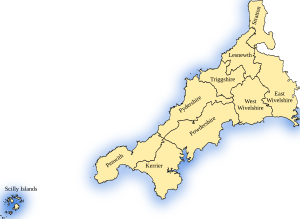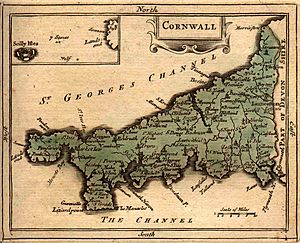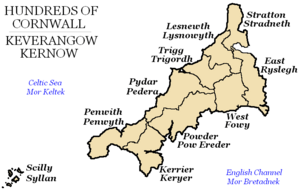Hundreds of Cornwall facts for kids
The hundreds of Cornwall were old ways of dividing up the land in Cornwall, a county in England. These divisions were used for managing the area from about 925 AD until 1894. After that, new local government districts took their place.
Some of these old divisions had names that ended with "shire," like Pydarshire and East and West Wivelshire. These names were first written down between 1184 and 1187.
In the Cornish language, the word keverang means "hundred." You can find this word in old place names, like Meankeverango, which means "stone of the hundreds." This stone helped mark the border between two hundreds: Penwith and Kerrier. The hundred of Trigg is even older, mentioned in the 600s as "Pagus Tricurius," meaning "land of three war hosts."
History of Cornwall's Hundreds
Historians believe that the idea of dividing land into "hundreds" in England started with King Athelstan. In 1083, a survey called the Geld Inquest found only seven hundreds in Cornwall. These were named after their main towns or areas: Connerton, Winnianton, Pawton, Tybesta, Stratton, Fawton, and Rillaton. These roughly match the later hundreds of Penwith, Kerrier, Pydar, Powder, Trigg, West Wivel, and East Wivel.
When the Domesday Book was created in 1086, it listed many details about the land. For Cornwall, the information was often grouped by these hundreds, even though the hundred names themselves weren't always used in the book.
Who Owned the Hundreds?
Most of the hundreds in Cornwall belonged to the Duchy of Cornwall. This is a special estate that provides income for the heir to the British throne. However, the hundred of Penwith was different; it belonged to the Arundell family.
The Arundells sold their ownership of Penwith in 1813. Owning a hundred came with many important rights. These included:
- The right to hear certain legal cases, like those about trespassing or debts.
- The power to choose a jailer to hold people who were arrested.
- The right to collect special payments from the owners of the main estates in the hundred.
- Claims over things like gold and silver mines, shipwrecks, and lost property found within the hundred.
Where Did the Names Come From?
The names of the hundreds have interesting origins:
- Penwith means "Land's End" in Cornish.
- Kerrier might come from an old name meaning "long fort."
- Lesnewth means a place where a "new court" was set up.
- Powder likely comes from a Cornish word meaning "territory."
- Pydar might mean "a fourth part."
- Stratton was an important area long ago.
- Trigg has its own story, which you can read about in another article.
- East and West Wivelshire originally had a Cornish name that is now lost. The English name was "Twofold-shire" because it was split into two parts. Over time, "Twofold-shire" became "Wivelshire."
Cornwall's Hundreds in 1841
By 1841, Cornwall was divided into ten hundreds. Each hundred was made up of several smaller areas called parishes. Here are the names of these hundreds:
- Penwith (Penwyth in Cornish)
- Kerrier (Keryer)
- Pydarshire (Pedera)
- Powdershire (Pow Ereder)
- Triggshire (Trigor)
- Lesnewth (Lysnowyth)
- Stratton (Stradneth)
- East Wivelshire (Ryslegh)
- West Wivelshire (Fawy)
- Scilly (Syllan)
Hundreds and Their Parishes
Each hundred contained many parishes, which are smaller local areas. For example, the Penwith hundred included parishes like St Buryan, Camborne, and St Ives. The Kerrier hundred had parishes such as Falmouth and Helston. While we won't list every single parish here, it's good to know that each hundred was a collection of these smaller communities.
Other Old Divisions of Cornwall
Besides the hundreds, Cornwall also had other medieval divisions:
- Brannel (Cornish: Bronel), meaning hilly place.
- Meneage (Cornish: Manahek), meaning monastic lands.
- Roseland (Cornish: Ros), meaning moor/heath.
- Rame Peninsula (Cornish: Ros), meaning moor/heath.
See also
- List of former administrative divisions in Cornwall













